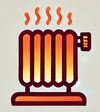To ensure your HVAC system runs efficiently, inspect your ductwork at least once a year. Look for signs of damage like holes or disconnected sections and check for dust buildup that can hinder airflow.
Regular inspections help you catch issues early, saving you money on repairs and improving indoor air quality. By following a few simple tips, you can keep your ducts in top shape and your home comfortable year-round.
Importance Of Ductwork Inspection
Ductwork inspection plays a crucial role in keeping your HVAC system running efficiently. Regular inspections help you spot damage like holes or disconnections. Catching these issues early saves you money on costly repairs.
You should also monitor dust accumulation inside the ducts. Dust can block airflow, making it harder for your HVAC system to circulate air. This not only wastes energy but also affects indoor air quality. Clean ducts mean cleaner air, reducing allergens and dust in your home.
Annual inspections enhance system longevity. When your ducts are clear and intact, your HVAC system can operate at peak performance. This leads to fewer breakdowns and longer-lasting equipment.
Overall, inspections create a comfortable living environment. Knowing your ducts are in good shape gives you peace of mind. Engaging in this preventive maintenance means you invest in your home’s overall health.
Common Ductwork Problems
Ductwork problems can disrupt your HVAC system and lower indoor air quality. Recognizing these issues early can save you time and money.
Signs Of A Problematic Duct System
- Unusual Noises: You might hear rattling or whistling sounds from your ducts. These noises often signal loose connections or blockages.
- Inconsistent Temperatures: You may notice hot or cold spots in different rooms. This variation can indicate leaks or improper airflow.
- Increased Energy Bills: A spike in your utility bills may mean your HVAC system is working harder due to duct issues. Inspecting for leaks or dirt can uncover the cause.
- Dust Accumulation: Regularly finding dust around vents suggests hindrances in your airflow. This buildup can stem from dirty ducts.
Impact On Indoor Air Quality
Duct problems can significantly affect indoor air quality. Poorly maintained ducts can circulate dust, allergens, and pollutants throughout your home.
- Allergen Spread: If your ducts harbor mold or dust, they can spread these irritants into the air. This circulation can heighten allergy symptoms or respiratory issues.
- Unpleasant Odors: Stale or musty smells often arise from issues within your duct system. Cleaning your ducts can help eliminate these unwanted odors.
- Health Risks: Contaminants trapped in ducts may lead to serious health concerns. Regular inspections help ensure cleaner air and a healthier environment.
Addressing issues in your duct system enhances your HVAC efficiency and ensures better air quality in your home.
Ductwork Inspection Tips
Ductwork inspections keep your HVAC system running smoothly. Regular checks catch issues early and improve indoor air quality. Follow these tips for an effective inspection.
Tools Needed For Inspection
To inspect your ductwork, gather these essential tools:
- Flashlight: Use a bright light to spot hidden damage or dust.
- Duct tape: Repair minor leaks and secure loose connections.
- Screwdriver: Access ductwork by removing vents or panels.
- Vacuum with hose attachment: Clean dust and debris from ducts.
- Thermometer: Measure temperature differences at vents to check airflow.
Step-By-Step Inspection Process
Follow these steps for a thorough duct inspection:
- Turn off the HVAC system: Ensure safety before starting the inspection.
- Inspect the vent covers: Look for dust buildup, signs of damage, or blockages.
- Check the duct joints: Look for gaps, discoloration, or loose connections.
- Assess insulation: Ensure it’s intact, uncompressed, and not wet.
- Look for blockages: Check inside ducts for any debris or obstructions.
- Listen for unusual noises: Pay attention to strange sounds during operation.
- Examine airflow: Use a thermometer to compare temperatures between vents.
- Seal any leaks: Use duct tape to secure problematic areas immediately.
By consistently following this process, your ductwork stays efficient and contributes to better air quality in your home.
When To Hire A Professional
Knowing when to hire a professional for your ductwork is crucial. Certain signs indicate that it’s time to call in the experts.
- Unusual Noises: If you hear banging, rattling, or whistling sounds coming from the ducts, those noises might suggest loose components or airflow issues.
- Inconsistent Temperatures: Different rooms might feel warmer or cooler than others. This could mean your duct system isn’t distributing air evenly, signaling a need for professional help.
- Increased Energy Bills: A sudden spike in energy costs may point to inefficient ducts or airflow problems. Professionals can identify the root cause and help restore efficiency.
- Dust Accumulation: Excessive dust around vents and in your home suggests leakage or blockages in your ducts. A professional can clean and seal the ducts properly.
- Poor Air Quality: If you notice allergies or respiratory issues worsening, dirty ducts may be to blame. Hiring a professional ensures a thorough cleaning and better indoor air quality.
- Mold Growth: Visible mold in or near air ducts poses health risks. Professionals can remove mold safely and prevent future growth.
- Age of Ducts: If your ductwork is over 15 years old, it might need an inspection. Ducts can deteriorate over time, affecting efficiency and air quality.
When you notice these signs, enlisting a skilled technician can restore your system’s performance and enhance your indoor environment.
Conclusion
Regular ductwork inspections are essential for maintaining your HVAC system’s efficiency and ensuring a healthy indoor environment. By staying proactive and addressing issues early on, you can prevent costly repairs and enhance air quality in your home. Use the tips provided to conduct thorough inspections and keep an eye out for signs of trouble.
If you encounter persistent problems or notice significant changes in system performance, don’t hesitate to call a professional. Investing time and effort into your ductwork will pay off in comfort and health for you and your family.








